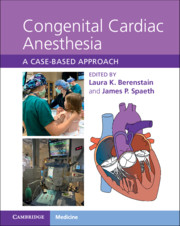Book contents
- Congenital Cardiac Anesthesia
- Congenital Cardiac Anesthesia
- Copyright page
- Dedication
- Contents
- Contributors
- Introduction
- Chapter 1 A Congenital Heart Disease Primer
- Section 1 Left-to-Right Shunts
- Section 2 Right-Sided Obstructive Lesions
- Section 3 Left-Sided Obstructive Lesions
- Section 4 Complex Mixing Lesions
- Section 5 Single-Ventricle Physiology
- Chapter 26 Stage I Palliation, Hypoplastic Left Heart Syndrome
- Chapter 27 Bidirectional Glenn
- Chapter 28 Lateral Tunnel Fenestrated Fontan
- Chapter 29 Extracardiac Fontan
- Chapter 30 Failing Fontan
- Section 6 Heart Failure, Mechanical Circulatory Support, and Transplantation
- Section 7 Miscellaneous Lesions and Syndromes
- Index
- References
Chapter 30 - Failing Fontan
from Section 5 - Single-Ventricle Physiology
Published online by Cambridge University Press: 09 September 2021
- Congenital Cardiac Anesthesia
- Congenital Cardiac Anesthesia
- Copyright page
- Dedication
- Contents
- Contributors
- Introduction
- Chapter 1 A Congenital Heart Disease Primer
- Section 1 Left-to-Right Shunts
- Section 2 Right-Sided Obstructive Lesions
- Section 3 Left-Sided Obstructive Lesions
- Section 4 Complex Mixing Lesions
- Section 5 Single-Ventricle Physiology
- Chapter 26 Stage I Palliation, Hypoplastic Left Heart Syndrome
- Chapter 27 Bidirectional Glenn
- Chapter 28 Lateral Tunnel Fenestrated Fontan
- Chapter 29 Extracardiac Fontan
- Chapter 30 Failing Fontan
- Section 6 Heart Failure, Mechanical Circulatory Support, and Transplantation
- Section 7 Miscellaneous Lesions and Syndromes
- Index
- References
Summary
The Fontan procedure has been adapted as a palliation for a variety of congenital heart diseases that result in single-ventricle physiology. Complications after Fontan palliation are common and include exercise intolerance, hepatomegaly, lymphatic dysfunction with protein losing enteropathy, ventricular dysfunction, and rhythm and conduction disturbances. Patients with Fontan circulation are experiencing improved long-term outcomes and longer life expectancy and hence present more often for noncardiac surgery. A comprehensive understanding of the Fontan circulation is required in order to provide safe care to both well-functioning and failing Fontan patients in the perioperative period.
Keywords
- Type
- Chapter
- Information
- Congenital Cardiac AnesthesiaA Case-based Approach, pp. 226 - 238Publisher: Cambridge University PressPrint publication year: 2021

